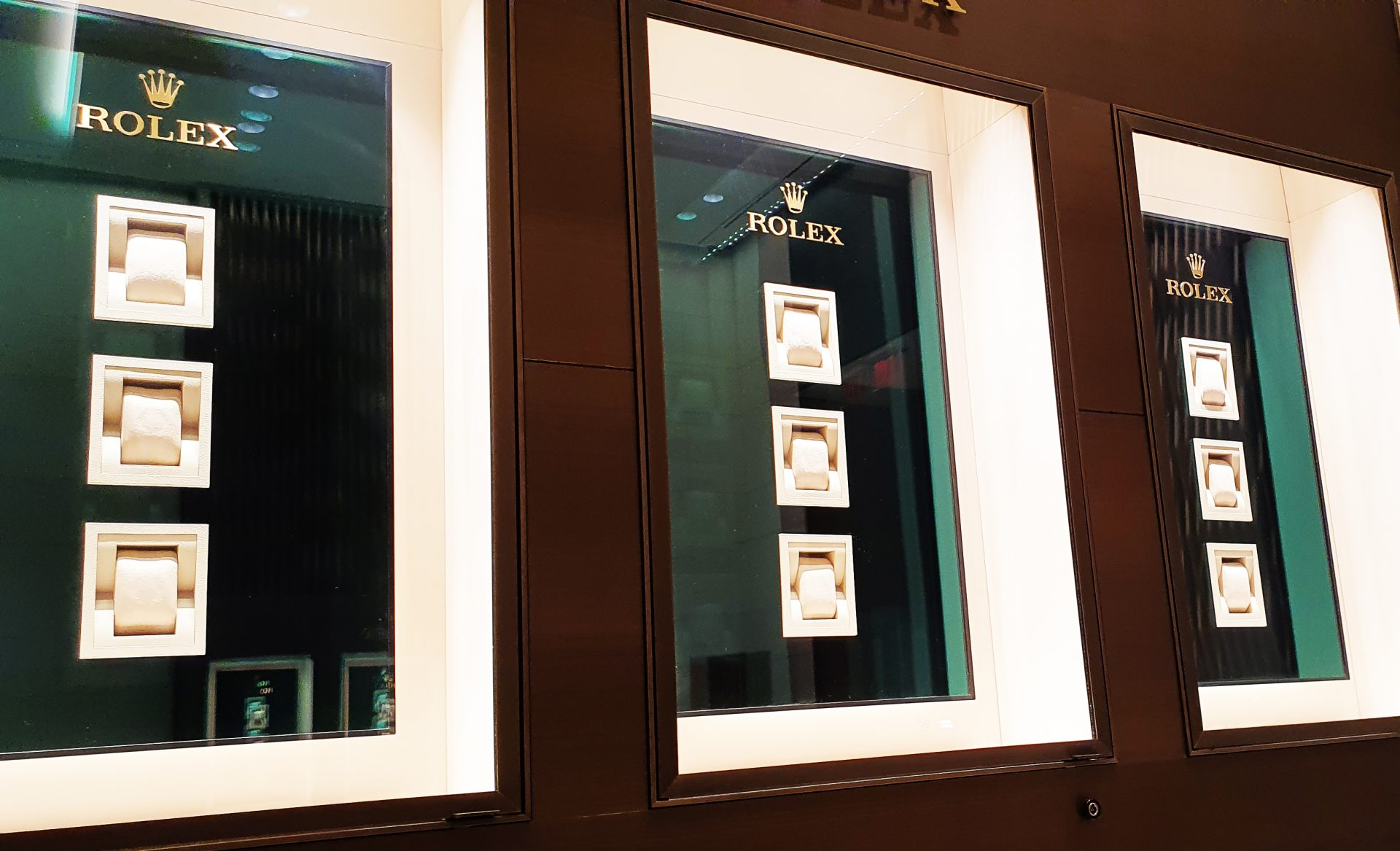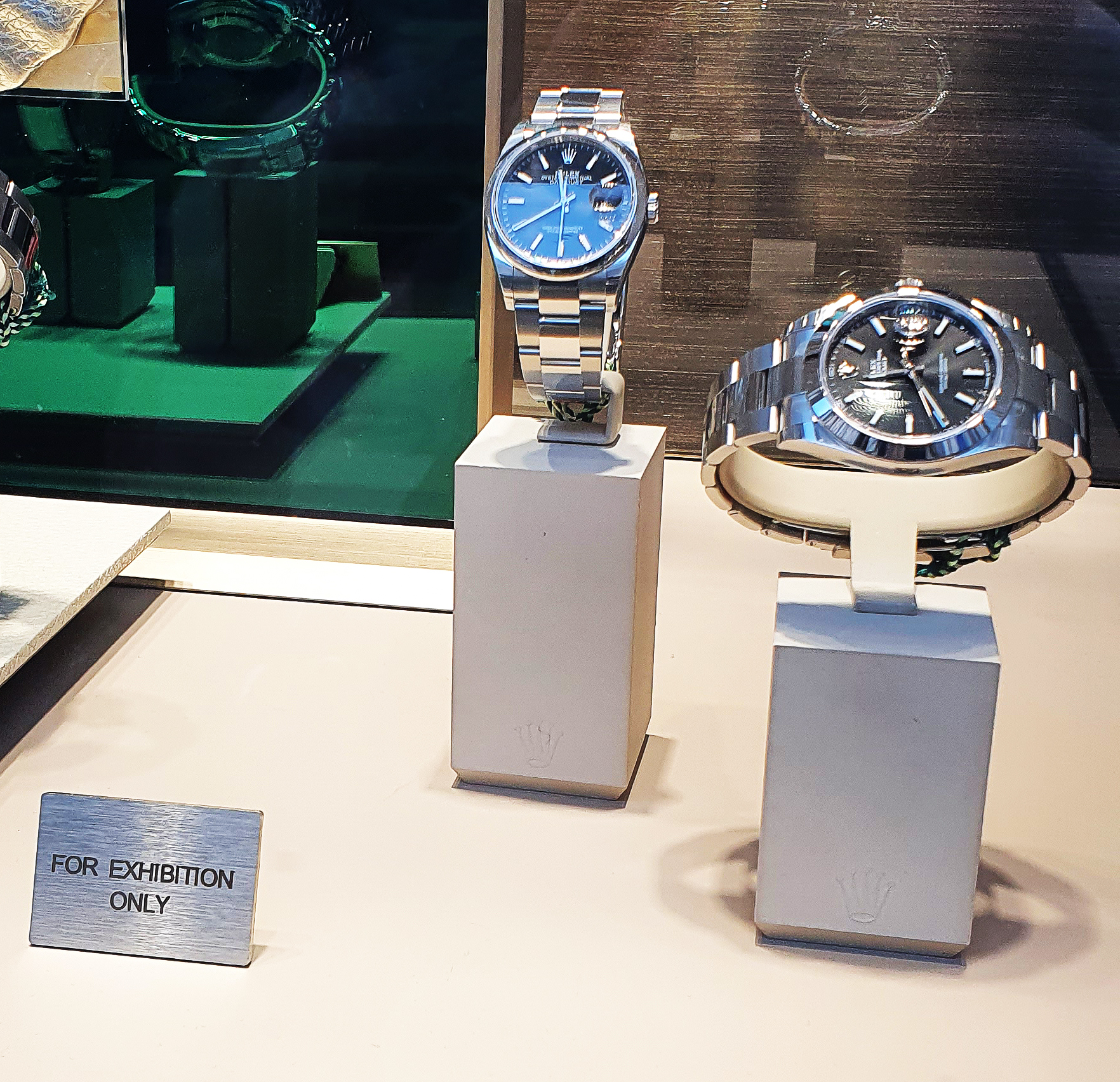Robin Swithinbank investigates how much ‘exhibition-only’ watches that can be seen but not bought are harming the industry.
It’s become a familiar scene. Walking through Geneva airport in June, I passed its Rolex boutique, where a rather gruff gentleman was quizzing a member of staff.
Why could he not have the watch in the window? Because it’s an exhibition model only, sir.
So when will you be getting one in?
Maybe next week, maybe in a few months. We never really know…
Impasse.

While the tone was far from incendiary, the frustration was palpable – on both sides. Not having the product you’re there to sell is one thing; to have no clear idea when you might get it another altogether.
Worse, the awkward but unspoken reality. Both sides knew that never in a month of Sundays was this guy getting his watch in that boutique. And yet there it was in the window.
I might have been anywhere. The same scenario is playing out every hour of every day in watch showrooms across the globe.
And not just for Rolex. Want a Vacheron Constantin Overseas? A Tudor chronograph? One of IWC’s new ceramic Pilot’s Watches? What about a Zenith Chronomaster Sport? Good luck.
And that’s without mentioning the usual suspects. Or MoonSwatch. I dropped into a Swatch store the other day to get a battery change for a few watches.
I was there less than 10 minutes and three people came in asking for MoonSwatch. Each turned away, wearing the same gloomy facial expression.
The industry needs to be careful here. Building hype and expectation makes sense, but only as part of a contract.
If you lead consumers to believe they can have something, only for them to discover they can’t and never will, the contract is broken. Broken contracts break trust. Broken trust ends relationship. And this business is all about relationship.
It’s no good for the public face of the watch industry, the sales force, either. Their job is to establish that trust, build those relationships and produce the one thing the industry relies on – customers. Who’d have their job right now?
Reports are of frazzled store staff brow-beaten by cheque book-waving customers to whom they have nothing to sell.
Some are being retrained in the art of the registration of interest. Lucky things. Others are being put on 20-minute shift cycles so they can decompress between interrogations. Some luxury watch stores have become shrinks’ waiting rooms.
The exhibition collection culture, now prevalent, has to be seen as the unwanted successor to waiting lists. These were already anti-consumer, but no one seemed to want to stop them coming.
At Dubai Watch Week in 2019, I chaired a discussion on ‘wait lists’, as the Americanisation has it. On the panel was Mohammed Seddiqi, head of the powerful Middle Eastern Seddiqi network of multiples.
He was unapologetic in his assessment of the then growing phenomenon, which largely affected only Rolex, Patek and the Royal Oak. Some customers would simply never get the watch they wanted, he said. Unless you’d bought your wife and your mother a Day-Date, you could forget getting your hands on a Nautilus.
His candour was shocking, even if it was refreshing. The Swiss, more encumbered by discretion, would not have made such a public declaration, even when they knew it to be true.
His line was also a portent, albeit in ways he could not have envisaged. Covid-fuelled boredom and lust, and filled bank accounts with unspent earnings, much of which were earmarked for luxury goods.
Meanwhile supply levels dipped. The result was perfect conditions for selling low-volume, high-end watches, as last year’s FHS reports of record export values proved.
There was a sense in the room that day in Dubai that what Mr Seddiqi was describing was somehow aspirational in itself. Yes, make the people wait! Desirability is wanting what you don’t have. And so on.
In the years since, brands hungry for a seat at high table seem to have picked up the formula. As a manufacturer, it’s always better if your order list is longer than your production capacity, right?
Lange, a pocket-sized brand by comparison to Patek and AP, makes 5,500 watches a year. Far fewer than it could sell in the current climate.
One of its most in-demand pieces is the Odysseus. The titanium model released at Watches and Wonders was adjudged to be one of the watches of the year.
And yet word is that since the line was introduced in 2020, fewer than 100 pieces have been made – in total. Hens have more teeth.
Watchmaking has a choice at this point. And it’s a simple one. Does it want to be a recherché, low-volume market serving the few? Or does it want to be a global force, a product and brand known and loved by many?
At that same event in Dubai, Jean-Claude Biver was given an hour on stage. Tub-thumping all the way, he urged the industry to think bigger.
Make more watches, sell more watches, generate more cash. Consumer appetite is there, he said, so if there are 7 billion people on the planet, how is it that Switzerland is only selling them 20 million watches a year? Three years on, that figure shows no signs of growing.
The industry isn’t entirely to blame here, if indeed we see this direction as a problem. We’re in an under-supply economy. Cars, PlayStations, cabin crew, dentists… Apparently there are too many of us and not enough of them.
 During Covid, watch supply chains were put out of whack, and many have yet to recover. The industry, for all it would have consumers believe it’s perfectly integrated inside Swiss borders, is a muddle, with a complex network of suppliers that crisscross countries and continents. Some suppliers went under during Covid, creating a parts shortage that echoes the tech world and its missing microchips.
During Covid, watch supply chains were put out of whack, and many have yet to recover. The industry, for all it would have consumers believe it’s perfectly integrated inside Swiss borders, is a muddle, with a complex network of suppliers that crisscross countries and continents. Some suppliers went under during Covid, creating a parts shortage that echoes the tech world and its missing microchips.
But beyond the fence, consumers neither know nor care. Which is a problem for the industry, which must not rely on consumer patience. People need cars; but they don’t need watches. And post-Covid, they have more to spend their money on again. Watchmaking knows better than most that if something better comes along, the consumer’s head will be turned. And the story can take an unexpected turn in the blink of an eye.
Waiting lists and exhibition collections may fuel the theory that luxury is simply something you can’t have, and therefore a sign of a healthy marketplace. But that’s true only to a point. There has to be some hope. It has to be worth the wait. Otherwise, what’s the point of paying attention in the first place?


This article encapsulates my feelings on the watch industry at this point. Started getting into watches in late 2019. Terrible timing! You can have all the interest and cash in the world, but if nothing is available, then what is the point? I refuse to even engage with Rolex, AP, Patek dealers at this point. They have literally nothing to sell and no control over their own inventory. It is a complete waste of time. I’m sure I can find something else to spend my disposable income on.
I’ve been victim more than once of “purchase history” fleecing attempts. The concept that you can sell a ton of watches off the back of a customer’s wants. Even better, if you’re like Watches of Switzerland, you can be secretive about your qualifying criteria, and suggest that buying watches from a different brand will go towards your Rolex GMT availablity.
The best part is stores don’t even check other branches for availability anymore, why would they? If they can get you on a waitlist, they can develop your purchase history to line their pockets.
This needs to stop. The manufacturers need to stop it, but we all know they won’t.
The distribution channels are the issue – the ADs will happily sell Rolex’s and the like to their big hitting customers without horrendous wait times and they are clearly being bumped to the very top of the lists. The issue with this is twofold.
One, it isn’t a level playing field for customers for even the cheapest Rolex models, and the whole relationship building with ADs just sucks. Watches that are produced in their tens or hundreds of thousands per year (Rolex circa 1 million a year) should be relatively straightforward to purchase. Two, customers like Barry Big Nuts don’t really care about getting their hands on a 3rd GMT or Submariner for their already vast collection, it’s simply hoarding (and flipping) for them. This just isn’t fair on real customers who see a ten grand watch as a genuinely special purchase as opposed to an investment to be locked away or flipped.
ADs need to be weeded out on this, or policies enforced. Already bought a Rolex from us in the past 3 years? Sorry mate you’ve had your piece of the pie. Bragging about an already vast Rolex collection? Clearly you don’t need another then pal.
If these brands want to avoid damage they need to be more inclusive, and that starts with the distribution channels. Going to an AD shouldn’t feel like a job interview.
Been trying for years to get a Rolex as something to pass on to son and him to his. Rolex are no longer worth trying to get as unless you are rich the Dealers are ‘t interested in you.
I have given up and look on Rolex as nothing now m, an imaginary company with no thought for the customer.